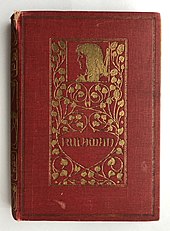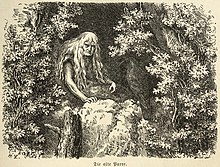Rulaman
Rulaman is a didactic youth novel by the German naturalist and writer David Friedrich Weinland from 1878.
Emergence
The youth novel Rulaman is to be seen against the background of the great interest in prehistory and early history that was awakening at the time. In 1856 the first skeleton of a Neanderthal man was discovered, and from the 1850s on, pile dwellings were excavated in Switzerland and southern Germany. In connection with the theories of Charles Darwin - The Origin of Species was published in 1859 - this led to numerous popular scientific and artistic treatments of prehistoric materials, whereby the range of topics of history painting and the historical novel was expanded.
Weinland writes, partly in explanatory and didactic sections, partly narrative, about the Stone Age and the beginning of the Bronze Age in his southwest German homeland, especially in the area around the Schiller Cave on the Swabian Alb , which Weinland served as a model for the Tulkahöhle. He wrote the book for his sons on the Hohen-Wittlingen estate near Urach .
It tells the adventures of the boy Rulaman. He is the son of chief Rul and belongs to the tribe of the Tulka from the "Aimats" people. Like many others in the book, this expression is taken from Lapland , as Weinland assumed that the Lappes might have constituted the indigenous people of Europe and were pushed to the edge of the continent by later Indo-European immigrants. In the course of the action, the Stone Age tribes of the Aimats living on the Swabian Alb come into contact with the “Kalats”, the Celts, who immigrate from the east . They are masters of metalworking, are technically superior to the Aimats and are quickly ousting the Stone Age people. The book was illustrated with woodcuts by Theodor Knesing based on drawings by Heinrich Leutemann .
structure
The book is divided into three parts. In the first part, "In the Gray Prehistoric Times", Weinland describes in detail the geological and historical background of the story, from the Paleozoic to the Ice Ages . The second part is the story of Rulaman and his tribe, the Tulka. In the third part, Weinland summarizes numerous footnotes and explains some terms in detail.
people
Rulaman
Rulaman is the chief's son. He is brave, brave and honest and everyone's role model. His great grandmother is old Parre, the sage of the tribe. From her he learns the history and customs of his tribe. On his forays and hunting he is accompanied by his wolf Stalpe. His best friend is Obu. Rulaman shows great interest in the kalats and their way of life. He visits her, accompanies her on the hunt and befriends the Kalats siblings Kando and Welda, through whom he learns a lot about the Kalats.
Rul
Rul is the leader of the Tulka, a strong man. As a sign of his chief status, he wears a white wolf's fur as a cape. He leads the tulka on their hikes and hunting expeditions. He dies in an argument with a hostile tribe. His successor as leader will be his youngest brother Repo.
Repo
Repo is the youngest brother of the leader Rul and his deputy. He succeeds in defeating the cave lion Burria. He is kind and generous. When Obu wants to marry the beautiful Ara, Repo stands up for Obu at Ara's grandfather Nargu.
The old Parre
She is the great grandmother of Rulaman. Nobody knows how old she is. Her long white hair falls almost to the floor, and her black raven sits mostly on her shoulders. Rulaman visits her frequently and listens to her tales from earlier times. She knows the healing properties of plants, prophesies things about the future of the tulka tribe and advises the tulka on problems.
Obu
Obu is four years older than Rulaman and his best friend. On a joint hunt for a bear, they meet the beautiful macaw from the Nalli tribe in the forest, and Obu falls in love with her. After several arguments between the Nalli and the Tulka, the two tribes make peace, and the leader, Ara's grandfather Nargu, agrees to the relationship between Obu and Ara. When Ara is kidnapped by the Kalats, Obu spent days looking for her in the forest. On the solstice festival of the Kalats he can free them.
Angekko
Angekko is the chief of the neighboring tribe of the Huhka. He is a sorcerer and doctor, and known and feared by all tribes. When someone is sick or injured, they are called for help. Angekko wears long white wolf fur and a reindeer fur coat. His hut is adorned with skulls and reindeer antlers; no one is allowed to enter. Sometimes he disappears in one of the passages reaching deep into the mountain to summon the earth spirits there. His favorite bird is the eagle owl, which often sits on his shoulders.
Nargu
Nargu is a wealthy flint hammer and trader. He is the chief of the Aimat tribe of the Nalli and lives in the largest cave in the area, the walls of which he decorates with pictures. His granddaughter is the beautiful macaw. Nargu speaks the language of the Kalats, as his mother is said to have been a Kalats woman. He worships cave bears , knows where they hide and sometimes brings them to eat.
The beautiful macaw
Ara is a granddaughter of the wealthy Nargu from the Nalli tribe. She is tall and slim and has a light skin color. Instead of the usual fur clothes, she wears a red wool dress that she received from her great-grandfather. Early in the morning she goes to search for herbs in the forest. As the only woman in the tribe, she carries a knife and is good with weapons and tools. She is brave and likes to go hunting with Obu and Rulaman. On one of these hunting expeditions she kills a white wolf and receives the honorary name Farkamate ( wolf killer ) as an award . She learned the Kalat language from her great-grandfather and translates it when the peoples meet.
Kando and Welda
Kando and Welda are siblings and the children of the Kalat chief. Kando is brave, fair and friendly and loved by everyone. He becomes friends with Rulaman. Welda is beautiful, compassionate, helpful, and kind. She also befriends Rulaman.
action
The young Rulaman is to be the successor of his father Rul. On his first hunting trip with adults, the hunter on a dangerous hit cave lion , the Burria is called. Chief Rul is badly wounded by the lion. Rulaman saves his father's life by striking the lion with his stone ax until the lion leaves Rul. The shaman Angekko is called to heal Rul. As a reward for his bravery, Rulaman receives a spear at the Burria Festival as a sign that he is now recognized as a man.
Later he helps his friend Obu to kill a cave bear so that he too can get the spear. Unfortunately, it was a bear protected by the wealthy chief Nargu, and a fight ensues between his tribe, the Nalli, and the Tulka. After the peace agreement between the two tribes, Obu finally gets the beautiful Ara, a granddaughter of the Nargu, to wife.
For a long time the tulka had only heard rumors about the kalats. On a hunt in spring they meet the mysterious people for the first time. Although the Kalats seem very friendly, the Tulka remain suspicious of strangers. Old Parre warned against them. Nevertheless, the tulka befriend the kalats and trade game, mushrooms and antlers for knives, arrowheads and swords made of metal. They learn to ride a horse and go reindeer hunting together. On a hunt, Rulaman meets the kalat boy Kando and his sister Welda and becomes friends with them.
At the big solstice festival the Kalats outsmart all invited Tulka, Nalli and Huhka, murder them and sacrifice them to their gods. All other tulkas are later killed by the Kalats under the leadership of their druid . Rulaman survives and is wounded and brought to safety. Together with the old Parre he hides in the Staffa cave, which is hidden and difficult to access in a steep rock face. Rulaman later meets his injured friend Kando and takes him to the cave too. Well cared for, Kando goes back to Wenda and his tribe, where he falls out with the druid.
He found out where Rulaman and old Parre are hiding through scouts and attacks the cave with a group of kalats. Parre can repel the attacks by knocking down the attacker's ladder and throwing vipers at them. Later she throws herself into the abyss, dragging the druid down with her. She had once prophesied to Rulaman that he would one day become the leader of the Kalats.
What happens to Ara and Obu is not told. But since old Parre heard cries of battle from the Tulka Cave one night, one must assume that they too were killed by the Kalats.
caves
The caves of the four tribes play a large part in the story, and a significant part of the action takes place in them. Weinland was inspired by caves in the Swabian Alb in their description. The Tulkahöhle can be compared with the Schillerhöhle near Weinland's former residence, the Nalli cave with the Nebelhöhle, the Huhkahöhle with the Falkensteiner Höhle , and the Staffahöhle corresponds to the Steffesloch near the Schillerhöhle.
Linguistic particularities
Weiland gave the animals, plants and people in his history names from numerous languages such as Gaelic , Hebrew , Latin , Lapland , Polish , Tatar and Arabic .
effect
Rulaman was a great success. The book has been published to this day and, because of the many regional references, is still popular, especially in southwest Germany. The total German circulation is estimated at over half a million copies. The book has been translated into Danish, English, French, Latvian, Dutch, Russian, Swedish, Serbo-Croatian and Spanish.
To mark the 125th anniversary of the book, an exhibition Rulaman the Stone Age Hero took place in the Braith Mali Museum in Biberach in 2004 .
Trivia
- In the municipality of Zollikon in canton Zurich younger are scouts that elsewhere as scouts or wolves are designated by Rulamans tribe since 1943 Tulka called. The name Tulka is also used in the neighboring municipality of Maur
- Part of the plot of the novel takes place in the Achtal near Blaubeuren . About 100 years after the novel was published, important Stone Age finds were made in the Geißenklösterle cave not far from the plot .
Illustrations
Individual evidence
- ↑ Zeit.de
- ↑ Lochstein.de
- ↑ Cojote outdoor.de
- ↑ Zeit.de
- ↑ Rulaman the Stone Age Hero at Archeology online
- ↑ after Kurt Kloeppel, in: David Friedrich Weinland: Rulaman , Tübingen 1972, p. 285
- ^ Archeology online
- ^ Website of the scout department in Zollikon
- ^ Website of the scout department Maur .
Web links
- DF Weinland : New youth and home library. Fifth series. Rulaman , Otto Spamer , Leipzig 1878 - digitized version at the Austrian National Library
- Günter Herburger: Rulaman by Christian David Friedrich Weinland in: Die Zeit , series "My Century Book", 1999
- Rulaman the Stone Age Hero ( Memento from June 21, 2008 in the Internet Archive ) Review of the exhibition in the Braith Mali Museum
-
 Rulaman public domain audiobook at LibriVox
Rulaman public domain audiobook at LibriVox









